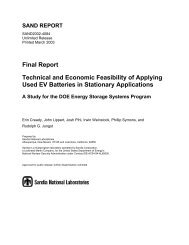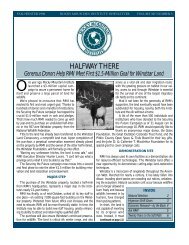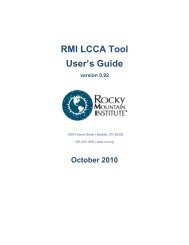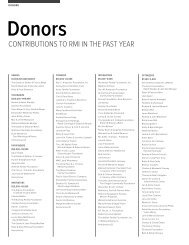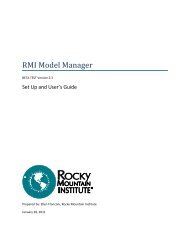Fleet Electrification Roadmap
Fleet Electrification Roadmap
Fleet Electrification Roadmap
- No tags were found...
Create successful ePaper yourself
Turn your PDF publications into a flip-book with our unique Google optimized e-Paper software.
24 primer: electrification of the transportation sectorspecial sectionspecial sectionfleet electrification roadmap 25Economic Costs of Oil DependenceFIGURE P6Monthly U.S. Petroleum Trade DeficitAlthough the United States remains the third largestproducer of petroleum in the world, U.S. oil productionhas fallen dramatically from its peak in 1970 as the sizeof new discoveries has fallen and the productivity of newwells has declined. 25 America now imports 58 percent ofthe oil it consumes, at tremendous cost to the currentaccount balance. 26 In 2007, the U.S. trade deficit in crudeoil and petroleum products was $295 billion. In 2008, asoil prices reached all time highs, that figure increased to$388 billion. 27 Based on current levels of oil imports andpetroleum prices, the U.S. trade deficit in crude oil andpetroleum products is on pace to return to pre-crisis levelsnear $300 billion in 2010. 28The share of petroleum trade in the overall U.S. tradedeficit has increased considerably in recent years. SinceDecember 2007, crude oil and petroleum products haveroutinely accounted for more than half of the monthlyU.S. trade deficit. 29 For the full year, oil trade accountedfor 56 percent of the total U.S. trade deficit in 2008 and55 percent in 2009. 30 In other words, oil now typicallyaccounts for a greater share of the U.S. trade deficitthan trade with any singlebilateral or regional tradeSince December 2007,crude oil and petroleumproducts have routinelyaccounted for more thanhalf of the monthly U.S.trade deficit.partner, such as China,NAFTA or the EU. Whilemore than 30 percentof net U.S. imports aresourced in North America,48 percent originate withOPEC member states withwhich the Unites Stateshas little else in the way ofeconomic relationships. 31A significant share of thedollars sent abroad to purchase oil from OPEC states isnot recycled into the U.S. economy, amounting to a simpletransfer of wealth.Direct wealth transfer is only one of the many economiccosts of American oil dependence. Researchersat the Oak Ridge National Laboratories (ORNL), have25 DOE, AER 2009, Figure 5.2.26 Id., Tables 5.1 and 3.9.27 Id., Table 3.9.28 DOE, EIA, October 2010 Short Term Energy Outlook; and DOE, EIA,Weekly Petroleum Status Report (October 6, 2010); SAFE analysis.29 U.S. Census Bureau, Office of Foreign Trade Statistics; EC analysis.30 Id.31 DOE, AER 2009, Table 5.4.Oil tanker moored in loading bay of oil refinery in Houston, Texas.studied at least two others. First, significant economiccosts stem from the temporary misallocation of resourcesas the result of sudden price changes. When oil pricesfluctuate, it becomes difficult for households and businessesto budget for the long term, and economic activityis significantly curtailed. Second, the existence of anoligopoly inflates oil prices above their free-market cost.As a result, some economic growth is foregone due tohigher costs for fuel and other products. ORNL studiesestimate the combined damage to the U.S. economy fromoil dependence between 1970 and 2009 to be $4.9 trillionin current dollars. 32 For 2008 alone, the cost was nearly$500 billion. 33Perhaps most tangibly, every recession over thepast 35 years has been preceded by or occurred concurrentlywith an oil price spike. In general, recessions arecaused by a myriad of factors and are damaging to nearlyall sectors of the economy. And yet, oil price spikes tendto exact a particularly heavy toll on fuel-intensive industrieslike commercial airlines and shipping companies.Additionally, automobile manufacturers tend to sufferdisproportionately as consumers dramatically scale backlarge purchases. But most important is the effect thatoil prices have on consumer spending, which representsabout 70 percent of the economy. Stated simply, whenconsumers spend more on gasoline (and heating oil), theyspend less on everything else.32 DOE, EERE, Vehicle Technologies Program, The Cost of Oil Dependence,available at http://www1.eere.energy.gov/vehiclesandfuels/facts/2010_fotw632.html, last accessed October 27, 2010.33 Id.80 Billions (Nominal $)70605040302010020002001Monthly U.S. PetroleumTrade Deficit2002FIGURE P7Oil Prices And Economic Growth10% Change in GDP86420-2-4-61970197519802003FIGURE P8Economic Costs of U.S. Oil Dependence$500 Billion $2007400300200100019701972197419761978198019821985200419902005Oil PricesLoss of Potential GDP19841986200619952007Change in GDP20002008Percent of TotalTrade DeficitSource: Figure P6 — U.S. Census Bureau; Figure P7 — U.S. Bureau of Economic Analysis; Figure P8 — Greene, David L., and Janet L. Hopson, "The Costs of Oil Dependence 2009"19881990Dislocation Losses199219941996Wealth Transfer199820002005200220092004100%90807060504030201002010per Barrel $1002006806040200-20-40-6020102008



